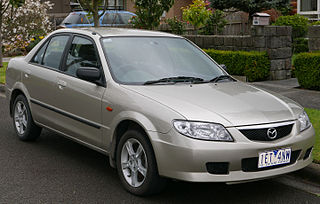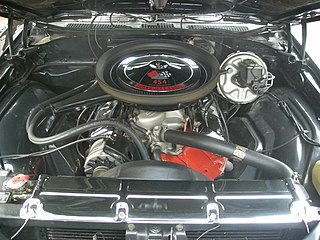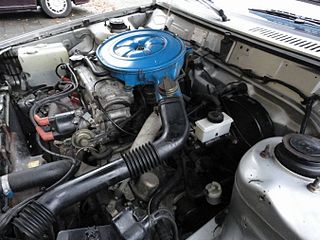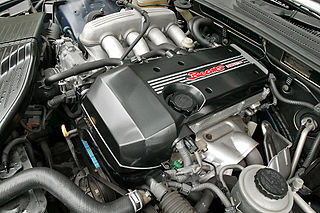
The Mazda Familia, also marketed prominently as the Mazda 323, Mazda Protegé and Mazda Allegro, is a small family car that was manufactured by Mazda between 1963 and 2003. The Familia line was replaced by the Mazda3/Axela for 2004.

The Chevrolet "big block" engine is a term for a series of large-displacement, naturally-aspirated, 90°, overhead valve, gasoline-powered, V-8 engines; that were developed and produced by the Chevrolet Division of General Motors, from the 1950s until present.

The F engine family from Mazda is a mid-sized inline-four piston engine with iron block, alloy head and belt-driven SOHC and DOHC configurations. Introduced in 1983 as the 1.6-litre F6, this engine was found in the Mazda B-Series truck and Mazda G platform models such as Mazda 626/Capella as well as many other models internationally including Mazda Bongo and Ford Freda clone, Mazda B-series based Ford Courier, Mazda 929 HC and the GD platform-based Ford Probe
The Mazda B-series engine - not to be confused with the Mazda B-Series truck - is a small-sized, iron-block, inline four-cylinder with belt-driven SOHC and DOHC valvetrain ranging in displacement from 1.1 to 1.8 litres. It was used from front-wheel drive economy applications to the turbocharged full-time 4WD 323 GTX and rear-wheel drive Miata as well as numerous other models. The Mazda B-series is a "non-interference" design, meaning that breakage of its timing belt does not result in damage to valves or pistons, because the opening of the valves, the depth of the combustion chamber and the shaping of the piston crown allow sufficient clearance for the open valves in any possible piston position.

The Mazda K-series automobile engine is a short stroke 60° 24-valve V6 with belt-driven DOHC and all-aluminium construction. Displacements range from 1.8 L to 2.5 L. They all use a 27-degree DOHC valvetrain with directly actuated hydraulic bucket lifters. The K-series also features a highly rigid aluminum split-crankcase engine block design with 4-bolt mains with additional bolts securing the lower block, an internally balanced forged steel crankshaft with lightweight powder forged carbon steel connecting rods. They were designed with the intent of being as compact as possible for short-hood front-wheel drive applications.

Mazda has a long history of building its own diesel engines, with the exception of a few units that were built under license.

The VK engine is a V8 piston engine from Nissan. It is an aluminum DOHC 4-valve design.

The VQ is a family of V6 24V automobile engines developed by Nissan with displacements varying from 2.0 L to 4.0 L. It is an aluminum block DOHC 4-valve design with aluminum heads. It is fitted with Nissan's EGI/ECCS sequential multi-point fuel injection (MPFI) system. Later versions feature various implementations of variable valve timing and replace MPFI with direct fuel injection. The VQ series engine was honored by Ward's 10 Best Engines list almost every year from the list's inception. The VQ series replaced the VG series of engines.

The GA engine is a 1.3 to 1.6 L inline-four piston engine from Nissan. It has a cast-iron block and an aluminum head. There are SOHC and DOHC versions, 8, 12, and 16 valve versions, carbureted, single-point, and multi-point injected versions, and versions with variable valve timing (GA16DE). The GA was produced from August 1987 through 2013. Since 1998, it was only available from Mexico in the B13.

Honda's first production V6 was the C series; it was produced in displacements from 2.0 to 3.5 liters. The C engine was produced in various forms for over 20 years (1985–2005), having first been used in the KA series Legend model, and its British sister car the Rover 800-series.

The Honda A series inline-four cylinder engine is used in 1980s Honda Accord and Prelude models. It was introduced in 1982, with the second-generation Honda Prelude, and available in three displacement sizes: 1.6-, 1.8- and 2.0-liters. It features cast iron block and aluminum SOHC head design with three valves per cylinder for a total of 12 valves. It was available in carbureted and fuel-injected configurations

The Toyota S Series engines are a family of straight-4 petrol or CNG engines with displacement from 1.8 L to 2.2 L produced by Toyota Motor Corporation from January 1980 to August 2007. The series has cast iron engine blocks and aluminium cylinder heads.

The Toyota E engine family is a straight-four piston engine series, and uses timing belts rather than chains. The E engines were the first multi-valve engines from Toyota designed with economy, practicality and everyday use in mind. Like many other Toyota engines from the era, the E engine series features a cast iron block, along with an aluminium cylinder head. E engines are lighter than earlier Toyota engines, due to the hollow crankshaft, thinned casting of the cylinder block, and several other reductions in auxiliaries as well as in the engine itself. Carbureted versions include a newly designed, variable-venturi carburetor. All of these changes improved economy and emissions. The members of the E engine family, range from 1.0 L to 1.5 L. The E family supplanted the K engines in most applications. A large number of parts in the E engine series are interchangeable between each other.

The HR is a family of straight-3 12-valve and straight-4 16-valve automobile engines with continuously variable valve timing, involving development by Nissan and/or Renault, and also Mercedes-Benz in the case of the H5Ht/M282. The designation of H engine is used by Renault, and M28x by Mercedes-Benz, to classify the family. There are three basic specifications of engine involving variations in engine architecture, or all-new architecture, with 72.2 mm (2.84 in), 75.5 mm (2.97 in) and 78 mm (3.07 in) bore diameter.

The Mitsubishi 4A9 engine is the newest family range of all-alloy inline four-cylinder engines from Mitsubishi Motors, introduced in the 2004 version of their Mitsubishi Colt supermini, and built by DaimlerChrysler-owned MDC Power in Germany.

The N series is Honda's first automotive diesel engine, an inline-four for medium-sized vehicles. It uses common rail direct injection, which Honda brands as i-CTDi. The most notable feature is the aluminium block, which uses proprietary technology in the manufacturing process to provide light weight and high rigidity. Roller chains drive two overhead camshafts. A variable-geometry turbocharger and intercooler are used.

The Mazda L-series is a mid-sized inline 4-cylinder gasoline piston engine designed by Mazda as part of their MZR family, ranging in displacement from 1.8L to 2.5L. Introduced in 2001, it is the evolution of the cast-iron block F-engine. The L-series is used by Ford as their 1.8L to 2.5L Duratec world engine.

The E0 series is a three-cylinder gasoline engine developed and manufactured by Honda, with a total displacement of 656 cc. The engine is intended for kei car applications. The E05A and E07A were partially replaced by the Honda P engine but as of 2020 the E07Z engine still saw use in the Acty truck.

The Toyota NR engine family is a series of small inline four piston engines designed and manufactured by Toyota, with capacities between 1.2 and 1.5 litres.
Skyactiv is a brand name for a series of automobile technologies developed by Mazda that increase fuel efficiency and engine output. The initial announcement of the Skyactiv technologies included new engines, transmissions, body, and chassis, which appeared in Mazda products from 2011 onwards.



















